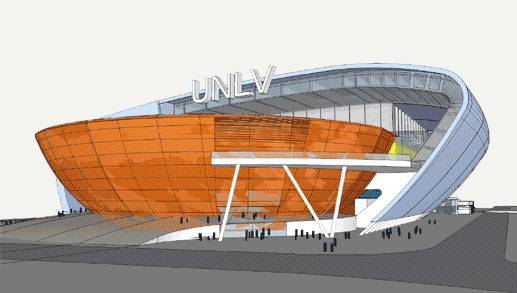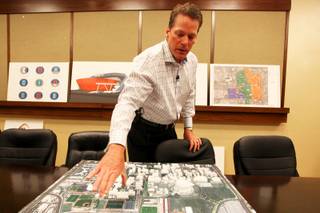
Courtesy UNLV Now
Renderings of a proposed stadium on the UNLV campus.
Published Tuesday, Sept. 13, 2011 | 2 a.m.
Updated Tuesday, Sept. 13, 2011 | 1:23 p.m.
Proposed project location
Sun archives
- Developers continue push for UNLV stadium, retail district (6-28-2011)
- Developers put early plans for UNLV stadium, retail district on display (2-1-2011)
- Regents to hear UNLV arena plan for football, basketball (1-31-2011)
- Mayor: UNLV domed stadium wouldn’t conflict with a downtown Las Vegas arena (1-27-2011)
- Report: UNLV domed stadium plans will be unveiled Tuesday (1-27-2011)
- Goodman: Arena project a key issue for next Las Vegas mayor (1-20-2011)
- UNLV acknowledges effort to bring stadium, football to campus (1-19-2011)
The public-private partners behind a proposed on-campus stadium at UNLV say they are developing a plan to build it without raising taxes.
Since the Legislature this year rejected a special tax district to fund the $2 billion stadium/dormitory/retail project, university administrators and Majestic Realty Co. have been working on a financial formula and other changes to allow the project to move forward.
Craig Cavileer, president of Silverton resort and Majestic’s representative on the project, said one idea is for UNLV to issue but not underwrite bonds to pay for construction, allowing the university to avoid liability should the project fail and investors sue. Another idea is for Majestic to fund the project.
Regardless of the source of financing, the stadium would be built on public land — west of the Thomas & Mack Center on space now used for parking — eliminating the need to pay hefty property taxes and seek a special state exemption from the tax.
Majestic Realty would lease the land from UNLV, and the two entities would split the profits 50-50, Cavileer said.
Changes to the project include:
• Building a 60,000-seat open-air stadium instead of a 40,000-seat domed stadium;
• Renovating the Thomas & Mack Center and building a promenade of retail establishments between the basketball arena and the stadium.
• Constructing 3,000 to 5,000 units of student housing.
“This project will not only bring football back to campus, but will create a true university campus lifestyle,” Cavileer said.
UNLV Athletic Director Jim Livengood said the project would be a “game-changer” not just for athletics but for the university as a whole.
“Without trying to get glossy, this changes the perception of the campus,” Livengood said. “We’re now perceived as a commuter school. This turns us into absolutely a residential campus. That’s how big a deal this is.”
Majestic Realty is the developer behind Los Angeles’ Staples Center, as well as part-owner of the Los Angeles Lakers and Los Angeles Kings.
Since 2007, the Las Vegas Valley has seen a number of stadium proposals come and go.
A sense of urgency over getting a state-of-the-art facility built has grown since completion in 2009 of the $1.2 billion stadium for the Dallas Cowboys. Its owner, Jerry Jones, has reportedly expressed interest in getting the National Finals Rodeo, a huge December event for Las Vegas, to move to his facility. If the UNLV project gets built, the rodeo would remain at the renovated Thomas & Mack.
“We believe that for NFR the (Thomas & Mack) provides for a great experience as is, and will only be better with the planned enhancements,” Cavileer said, adding that changes to the arena aren’t yet finalized.
During this year’s legislative session, a handful of would-be arena developers sought approval for taxing districts to pay for their projects. When the Legislature said “forget it,” most plans disappeared.
Behind the scenes, UNLV and Majestic kept working.
Its proposal and one other — on federal land in Henderson — appear to be the two left in the game. Last week, the Henderson City Council unanimously approved an agreement allowing a developer to do a feasibility and design study for a multibillion-dollar, multiphased project on 485 acres south of the Strip, near M Resort. Costing $1.3 billion, the first phase would include a 17,500-seat arena and 25,000-seat open-air stadium.
The Majestic project could have an edge because it is closer to the Strip while not being tied financially to a Strip casino. Casino representatives have been at odds over various proposals, arguing that any public funding for an arena or stadium associated with a casino would be unfair to competing properties.
Majestic executives said pro sports franchises could be future tenants of the facility. An NFL team isn’t part of the plan, Cavileer said, but it is well-known that Major League Soccer is interested in Las Vegas. And the National Hockey League might be interested and the National Basketball Association has “from time to time” expressed interest, he said. He also said the NFL’s Pro Bowl, traditionally held in Hawaii, might be a good fit.
Plans changed from the enclosed stadium, which could have only accommodated 40,000 seats, to the larger stadium because the smaller venue would “not work well as UNLV athletics grows nor does it work well to attract those events and teams to Las Vegas which are important” to tourism, Cavileer added
“This is an ambitious project and the university is, in our mind, the best recipient of that energy,” Cavileer said.
If the Nevada System of Higher Education Board of Regents agrees to an exclusive negotiating agreement with Majestic in December, Cavileer said construction could begin within 18 to 24 months and be complete about two years later.
Livengood said having an on-campus stadium with thousands of students living nearby could one day create a “buzz” similar to that felt in Madison, Wis., where UNLV’s football team played this month.
“You don’t even have to go to the game there, it’s just a great college atmosphere all around. That’s what could happen here,” he said. The project would signal “that we’re really serious about our university, because this isn’t just for athletics, this is for everybody.”


Join the Discussion:
Check this out for a full explanation of our conversion to the LiveFyre commenting system and instructions on how to sign up for an account.
Full comments policy